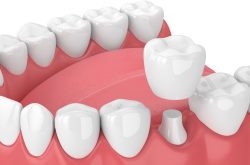Dental Crowns (Cap)
-
Medically Reviewed by Greg Grillo, DDS | Last updated 10/17/2023
- Overview
Overview
What are dental crowns?
Also commonly referred to as a “cap,” a dental crown is a fixed dental restoration that is placed on top of a damaged tooth, dental implant, or bridge to replace a missing tooth. Crowns are used in many different dental procedures ranging from dental fillings and root canal therapy, to full-mouth reconstruction and smile makeover.

Dental Crown Before & After Photo
Cost of dental crowns
The average cost of dental crowns ranges from $800 to $2,500 per tooth according to the American Dental Association (ADA). The following are some general cost estimates for various types of dental crowns:
- Porcelain-fused-to-metal (PFM) crowns: $800 to $1,500 per tooth.
- All-ceramic or all-porcelain crowns: $1,000 to $2,500 per tooth.
- Zirconia crowns: $1,000 to $2,500 per tooth.
Factors affecting the cost of treatment
There are several factors that can affect the cost of your procedure. The following are some of the top factors that influence cost.
- Your Dentist: In some cases, highly experienced cosmetic dentists charge more for their services. When researching dentists, look for those certified by the American Board of Dental Specialties (ABDS) or the American Society of Cosmetic Dentistry (AACD). Although board-certification and memberships in any organization does not guarantee a successful outcome, dentists must meet stringent criteria in order to achieve membership and board-certification. You can be confident that you are working with a highly trained, and experienced dentist who will help ensure your dental crown procedure goes smoothly.
- Location Matters: Dental services in urban areas with a higher cost of living may charge more for their services compared to rural areas.
- Type of Material: Common crown materials include porcelain-fused-to-metal (PFM), all-ceramic or all-porcelain, zirconia, and metal alloys. Different materials have varying costs.
- Number of Teeth: Replacing multiple teeth with crowns will increase the overall expense compared to a single-tooth crown.
- Complexity of Case: Cases that require significant work may result in higher costs.
- Additional Treatments: In some cases, crowns may be part of a comprehensive treatment plan that includes other procedures which can increase the overall cost.
- Insurance: In certain cases, crowns may be covered by insurance if it’s deemed necessary for functional purposes.
If you are considering dental crowns, schedule a consultation with an experienced cosmetic dentist near you. This will allow you to discuss your dental goals and gain a thorough understanding of the specific cost breakdown and factors that pertain to your individual case.
Is the cost covered by insurance?
Dental insurance coverage can vary based on your specific plan and the provider. Here are some important points to keep in mind when it comes to dental coverage:
- Coverage Percentage: Typically, dental plans cover a certain percentage of the cost. This percentage often falls between 50% to 80% of the allowed fee, leaving the remaining percentage as the patient’s responsibility.
- Limitations & Waiting Periods: Some plans may have waiting periods before they start covering certain procedures. Also, there might be limits on how many crowns are covered within a specific time-frame.
- Alternate Benefit Clause: Some plans include an alternate benefit clause, meaning they’ll only cover the cost of the least expensive treatment option. If you opt for a more costly crown material and your plan only covers the cost of a metal or porcelain-fused-to-metal crown, you might have to cover the price difference.
- Annual Maximums: Most plans set an annual maximum coverage limit. This is the maximum amount they’ll pay for dental treatments in a calendar year. If the cost of your crown surpasses this annual maximum you’ll be responsible for the remaining balance.
- Pre-Authorization: Many plans require pre-authorization before covering major dental procedures. This means your treatment plan needs to be reviewed and approved by the insurance company before you undergo the procedure.
To get a better understanding of your dental insurance coverage, contact your insurance provider directly. They can provide you with the specific details of your coverage and help you understand how it applies to your dental needs. For more information about the basics of dental insurance, visit National Association of Dental Plans (NADP).
Are you a candidate?
Dental crowns offer a durable, aesthetically pleasing solution to a number of dental concerns. If you suffer from any of the following issues, a dental crown could be the perfect solution:
- Severe dental cavity that cannot be filled due to a lack of remaining tooth structure.
- A broken or fractured tooth that cannot be fixed with dental bonding.
- Weakened tooth or teeth in need of support to prevent fracture.
- Had a root canal and need to protect the restored tooth.
- Discolored or misshapen tooth that needs to be replaced.
- Received dental implants and need to cover them.
Types of dental crowns
Dental crowns can be fabricated from a number of different materials, each with their own pros and cons.
- Porcelain/Ceramic Crowns: These crowns are more expensive than the other options. They are often used when a crown is required to replace one of the front teeth, or if you have metal allergies.
- Pressed Ceramic Crowns: These crowns have a hard-inner core that replaces the metal liner used in all-ceramic crowns. They are capped with porcelain and can be color-matched to provide the best aesthetics. Pressed ceramic crowns last longer than all-porcelain crowns.
- Porcelain-Fused-to-Metal Crowns: These crowns are a hybrid between all-ceramic porcelain crowns and metal crowns. The visible structure is made of porcelain and fused to metal creating a stronger, more durable bond. Porcelain-fused-to-metal crowns are a good option for replacing molars.
- Resin Crowns: These crowns are typically cheaper than other options. However, they wear down over time, and tend to break easier than porcelain-fused-to-metal crowns.
- Metal Crowns: These can be made of several different metals, including nickel, chromium, palladium, or gold. They rarely chip or break, and only require a small amount of tooth to be removed.
Some factors your dentist may consider when selecting the material for your crown include:
- The location and function of the tooth that needs the crown
- The position of your gum tissue
- How much (if any) of the natural tooth remains
- The color of your natural teeth
Your dentist will discuss with you which type of dental crown is best suited to your needs.
Fabricating and placing crowns
Depending on your dentist, the process of getting a crown may be done same-day, or over multiple days.
Same-Day Crown Placement
The same-day procedure allows you to receive your crowns much more quickly. Your dentist uses computer-aided design/computer-aided manufacturing (CAD/CAM) to fabricate your crown in-house. That day, you should expect:
- Your dentist examines your mouth and takes digital pictures.
- Using these images, the crown is made in-office from a block of ceramic.
- Once the crown is completed, your dentist will bond it with special adhesive or attach it to the dental implant.

Multi-Day Placement
Traditional crowns usually require two separate visits to your dentist’s office.
- During the first visit, your dentist performs a thorough examination, takes x-rays, and makes a mold of your mouth.
- Your dentist then prepares your tooth for the crown by filing it down to remove the outer layer.
- An impression is made of your filed-down, prepared tooth and the surrounding natural teeth.
- Your dentist will place a temporary crown over the prepared tooth while your crown is being fabricated.
- The impression is sent to an offsite laboratory that fabricates the crown; this process may take several weeks.
- Once the crown is completed, you will have your second visit to remove the temporary crown, and permanently bond the new crown onto your tooth.
Alternatives to dental crowns
There are several alternatives to dental crowns, depending on the specific dental issue or condition you are trying to address. Here are some common alternatives:
- Dental Veneers: Veneers are thin shells made of porcelain or composite resin that are bonded to the front surface of the teeth. They can be used to improve the appearance of stained, chipped, or misaligned teeth. Veneers are a more conservative option compared to crowns as they require minimal tooth preparation.
- Dental Bonding: Dental bonding involves the application of a tooth-colored composite resin material to the tooth surface. It can be used to repair chips, cracks, and minor tooth damage. Bonding is a quick and cost-effective alternative to dental crowns, although it may not be as durable or long-lasting.
- Inlays and Onlays: Inlays and onlays are indirect restorations that are used to repair larger areas of tooth damage or decay. They are made in a dental laboratory and then bonded to the tooth. Inlays are used to repair damage within the cusps of the tooth, while onlays extend to cover one or more cusps. Inlays and onlays provide a conservative alternative to dental crowns by preserving more natural tooth structure.
- Orthodontic Treatment: In cases where the main concern is misalignment or spacing issues, orthodontic treatment may be an alternative to crowns. Braces or clear aligners can help reposition teeth and correct bite problems, eliminating the need for extensive crown work.
- Dental Implants: If a tooth is severely damaged or missing, dental implants may be considered. Implants involve the surgical placement of an artificial tooth root (titanium post) into the jawbone, which then supports a crown. Dental implants provide a long-lasting and stable solution for replacing missing teeth.
- Tooth Whitening: If the main concern is tooth discoloration or stains, professional tooth whitening treatments can be an effective alternative to crowns. Whitening treatments can help brighten and rejuvenate the appearance of natural teeth.
The choice of alternative treatment depends on factors such as the specific dental condition, the amount of tooth structure remaining, aesthetic preferences, and the recommendations of your dentist. It’s best to consult with a dental professional who can evaluate your case and provide personalized recommendations for the most suitable alternative to dental crowns.
EnhanceMyself.com relies on sources such as professional medical organizations, government agencies, academic institutions, and peer-reviewed scientific journals to write it’s articles. Learn more about how we ensure our content is accurate, in-depth, and unbiased by reading our editorial guidelines.
*Medical Disclaimer: This website does not provide medical advice. Read more.

